
- Reviews
- Power List 2024
- Cannes 2024
- In-Depth Stories
- Web Stories
- News
- FC Lists
- Interviews
- Features
- FC SpecialsFC Specials

Lily Gladstone's Oscar nomination for Best Actress in the epic western drama Killers of the Flower Moon (2023) is making history. She’s one of the few women in director Martin Scorcese’s filmography to stand shoulder to shoulder with male counterparts, sharing and eventually stealing the spotlight from them. Don’t take my word for it. Meryl Streep famously said, “I would like Martin Scorsese to be interested in a female character once in a while, but I don’t know if I’ll live that long.” However, Scorsese has long defended his films saying he spotlights the story that deserves to be told. From that perspective, there’s no doubt that Gladstone's Mollie Kyle makes the cut. Even though Leonardo DiCaprio and Robert De Niro stand at the centre of this gut-wrenching tale of the genocide of the Osage people, it is because of Gladstone that the Osage don’t become absent presences. Mollie may appear late but once she arrives, it’s clear that she is the film’s conscience and its spine. Gladstone is not just the first Native American actor to receive an Oscar nomination, she’s also a favourite for the win in a category that’s packed with extraordinary talent.
Gladstone's performance stands out for the depth and nuance she’s able to bring to Mollie, making her so much more a token Native presence in Killers of the Flower Moon. She may be defined by her cultural background, but Gladstone gives Mollie vitality, infusing the character with a sparkle of mischief, a nervy confidence, bright-eyed longing and eventually a gritty resilience to outsmart the schemes of the predatory white men who surround her. The languor in her voice as she hushes Ernest (DiCaprio) in the scene where she invites him home for a drink on a rainy night fills the moment with a sensuality that feels as delicious as it is menacing. Her desire for Ernest — the white man had an exotic appeal for many Osage women, we’re told — endangers her, allowing Gladstone to create a character who is a mesmerising mix of strength and vulnerability. Mollie may follow in the footsteps of other Osage women, but she never feels like a stereotype. Gladstone's ability to convey Mollie's emotions through her eyes lets viewers feel Mollie's unwavering belief in Ernest against all odds and logic. When he abuses her faith in him and exploits a love that is unbearably innocent in a world that is slick with oily cynicism, Mollie’s heartbreak is one that we feel with her. The arresting stillness that Gladstone lends to Mollie is also tremendous. Less is indeed more — a fleeting smile, a subtle side-eye, the profound grief as she surrenders to her murderous husband's touch; these moments and silences speak volumes in Killers of the Flower Moon.
Towards the end of the film, Mollie has a final confrontation with Ernest in a desperate attempt to understand his actions. In a matter of seconds, Mollie’s eyes reflect her questions, sympathy, love, rage, resentment, disgust, resignation, and indifference. It’s a magnificent moment and a breathtaking acting feat.
Historically, Hollywood has had little time for Native stories and when Native characters have been allowed on screen, they’ve often been played by white or Latino actors who were forced into stereotypical portraits of the savage indigene. Even when Native actors did make the cut, the roles they played were inevitably marginal. Take for example, The Last of the Mohicans (1992), which is one of the few mainstream films that made space for Native actors, giving the likes of Wes Studi and Russell Means significant roles while undercutting the dignity of their characters by leaning into clichés. They get to be the ‘savages’, ranging from noble to bloodthirsty, while Daniel Day Lewis stands in the centre as white saviour. Few indigenous actors have been given the opportunity to represent their communities with pride and fewer still have received recognition. Graham Greene received a Best Supporting Actor nomination for Dances With Wolves (1990), Keisha Castle-Hughes got a Best Actress nod for Whale Rider (2002), and Yalitza Aparicio received a Best Actress nomination for Roma (2018). The scarcity of examples is glaring.
Gladstone’s nomination is especially significant because she is so obviously deserving. This is not a case of “Oscar bait” or a nomination that is the result of awakened consciences, but a performance that has proved itself to be powerful enough to demand a wake-up call from the acting fraternity. Gladstone's nomination represents a positive shift with her being the first Native American to get a Best Actress nomination, but her presence also highlights the importance of providing equal opportunities for indigenous actors. To be discovered by Scorcese is a win that puts Gladstone with the best of Hollywood, but to be discovered at the age of 37, despite having the prodigious talent that Gladstone does, points to a systemic problem.